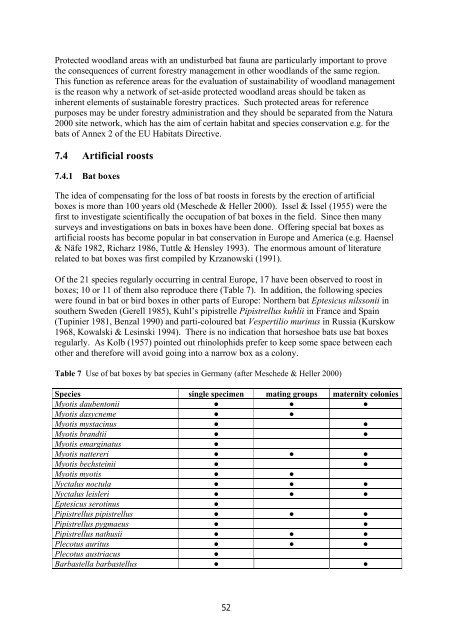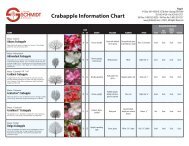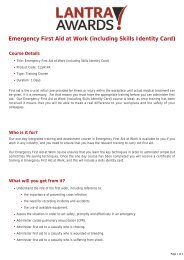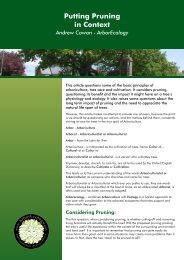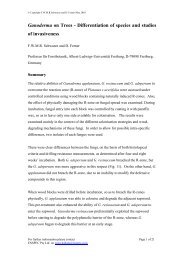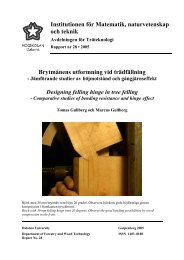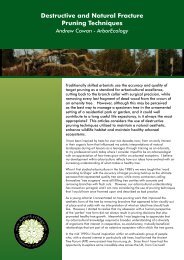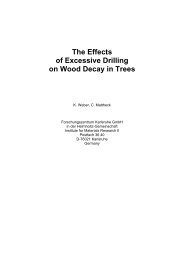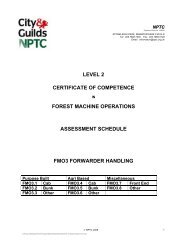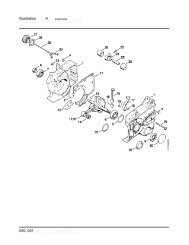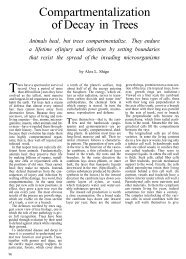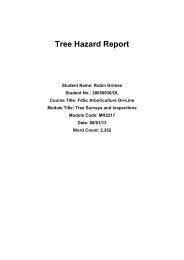Protected woodland areas with an undisturbed bat fauna are particularly important to provethe consequences of current <strong>for</strong>estry management in other woodlands of the same region.This function as reference areas <strong>for</strong> the evaluation of sustainability of woodland managementis the reason why a network of set-aside protected woodland areas should be taken asinherent elements of sustainable <strong>for</strong>estry practices. Such protected areas <strong>for</strong> referencepurposes may be under <strong>for</strong>estry administration and they should be separated from the Natura2000 site network, which has the aim of certain habitat and species conservation e.g. <strong>for</strong> thebats of Annex 2 of the EU Habitats Directive.7.4 Artificial roosts7.4.1 Bat boxesThe idea of compensating <strong>for</strong> the loss of bat roosts in <strong>for</strong>ests by the erection of artificialboxes is more than 100 years old (Meschede & Heller 2000). Issel & Issel (1955) were thefirst to investigate scientifically the occupation of bat boxes in the field. Since then manysurveys and investigations on bats in boxes have been done. Offering special bat boxes asartificial roosts has become popular in bat conservation in Europe and America (e.g. Haensel& Näfe 1982, Richarz 1986, Tuttle & Hensley 1993). The enormous amount of literaturerelated to bat boxes was first compiled by Krzanowski (1991).Of the 21 species regularly occurring in central Europe, 17 have been observed to roost inboxes; 10 or 11 of them also reproduce there (Table 7). In addition, the following specieswere found in bat or bird boxes in other parts of Europe: Northern bat Eptesicus nilssonii insouthern Sweden (Gerell 1985), Kuhl’s pipistrelle Pipistrellus kuhlii in France and Spain(Tupinier 1981, Benzal 1990) and parti-coloured bat Vespertilio murinus in Russia (Kurskow1968, Kowalski & Lesinski 1994). There is no indication that horseshoe bats use bat boxesregularly. As Kolb (1957) pointed out rhinolophids prefer to keep some space between eachother and there<strong>for</strong>e will avoid going into a narrow box as a colony.Table 7 Use of bat boxes by bat species in Germany (after Meschede & Heller 2000)Species single specimen mating groups maternity coloniesMyotis daubentonii ● ● ●Myotis dasycneme ● ●Myotis mystacinus ● ●Myotis brandtii ● ●Myotis emarginatus●Myotis nattereri ● ● ●Myotis bechsteinii ● ●Myotis myotis ● ●Nyctalus noctula ● ● ●Nyctalus leisleri ● ● ●Eptesicus serotinus●Pipistrellus pipistrellus ● ● ●Pipistrellus pygmaeus ● ●Pipistrellus nathusii ● ● ●Plecotus auritus ● ● ●Plecotus austriacus●Barbastella barbastellus ● ●52
Types of boxes used by batsThere are principally four types of boxes used by bats:• hollow bird boxes with the entrance at the upper third of the box;• hollow bat boxes with the entrance at the lower quarter of the box;• flat bat boxes which <strong>for</strong>m a crevice to be entered from below and;• large bat boxes suitable <strong>for</strong> hibernating bats.Many variants are described in the literature (reviewed by Haensel & Näfe, 1982, and Kuthe& Ibisch, 1989). Experiences with the different bat boxes are also diverse. However, it isgenerally agreed that specialist bat boxes are much more suitable <strong>for</strong> bats than bird boxes(Bäumler 1988, Nagel & Nagel 1988, Schwarting 1990, Schwenke 1988b). Most bird boxesare available <strong>for</strong> bats only after the birds’ breeding season (Schlapp 1990). Bechstein’s bat,<strong>for</strong> example, was present in 1% of bird boxes in a Bavarian <strong>for</strong>est during the birds’ breedingseason, but was observed in more than 25 % of the boxes afterwards (Schlapp 1981). Hollowbat boxes are not appropriate <strong>for</strong> birds and songbirds manage to nest in them in only a fewcases (Haensel & Näfe 1982).European bat species show different preferences <strong>for</strong> bat boxes. Nathusius’ pipistrelle andBrandt’s bat prefer crevices and are recorded mostly if flat bat boxes are offered as roosts(Heise 1983a, Dieterich & Dieterich 1988). Other species, such as Bechstein’s bat andnoctule, need more space and prefer hollow bat boxes, at least <strong>for</strong> colonies (Kerth 1998,Heise & Blohm 1998).Bat boxes are usually made of wood or concrete mixed with 70-80 % sawdust (Meschede &Heller 2000). Wooden boxes were preferred in eastern German woodlands (e.g. Stratmann1973, Schmidt 1977, Heise 1983a, Iffert and others 1989, Labes 1989). Their ‘lifetime’ isabout 10-12 years (Hackethal & Oldenburg 1983) but this can be extended by a cover ofroofing felt (Heise 1980). Other authors claimed the concrete boxes to be more suitable tobats (e.g. Henze 1968, Gerell 1985), because they are more resistant to rain and woodpeckersand they survive <strong>for</strong> about 25-30 years (Henze 1963, 1991). The microclimate in the box isto some degree dependent on the material but this seems to be less important to bats(Meschede & Heller 2000). Plastic is not appropriate as bat box material because its surfaceis too smooth <strong>for</strong> bats to climb it and they may become trapped in the box (Taake & Vierhaus1984).It is an advantage that bat boxes give room to the bats above the entrance in a similarstructure to woodpecker holes, which are enlarged at the top by rotting processes. Bats canhang in the dark above the entrance and are well protected from draughts and predators(Dieterich 1982). The <strong>for</strong>m of the entrance seems to be of minor importance. However, itmust not be too small. For example pregnant Daubenton’s bats have difficulties entering abox through a round hole of 26 millimetres diameter or less (Dieterich & Dieterich 1991).Pregnant noctules avoid entrances narrower than 15 mm (Heise & Blohm 1998).The construction of a bat box should also consider bat faeces, which might accumulatequickly when the box is occupied by a colony (Laufens 1973, Heise & Blohm 1998). Boxeswhere faeces can fall out are most appropriate. Other types must have enough space belowthe entrance so that a bat must neither crawl through faeces nor the entrance become blocked53
- Page 3: English Nature Research ReportsNumb
- Page 7 and 8: ContentsPreamble1. Legal aspects...
- Page 9 and 10: 1. Legal aspectsThere are three int
- Page 11 and 12: to the Agreement decided that the c
- Page 13 and 14: Country European Community EUROBATS
- Page 15 and 16: types in Europe where many of the e
- Page 17 and 18: • the European Commission initiat
- Page 19 and 20: Foraging areas: Central European sp
- Page 21 and 22: Other roosts: In foraging areas and
- Page 23 and 24: Brandt’s bat travels up to 250 ki
- Page 25 and 26: others 2004). Maternity colonies al
- Page 27 and 28: 1995, The Netherlands: Limpens and
- Page 29 and 30: from a maternity colony covered a t
- Page 31 and 32: hibernaculum is the Levensau Bridge
- Page 33 and 34: female (Fuhrmann and others 2002).
- Page 35 and 36: Foraging areas: In Central Europe f
- Page 37 and 38: Table 2 Importance of tree holes fo
- Page 39 and 40: sites it was found that the possibi
- Page 41 and 42: advancing age of a tree its potenti
- Page 43 and 44: floor up to the canopy and beyond c
- Page 45 and 46: Table 6 Overview of the most freque
- Page 47 and 48: 6.2 2nd step: Active search for roo
- Page 49 and 50: This first approach to a woodland b
- Page 51: number of tree-dwelling birds in pr
- Page 55 and 56: oxes exposed to the sun. As an exam
- Page 57 and 58: Con: Bats use bat boxes selectively
- Page 59 and 60: 9. ReferencesABULADZE, A., BUXNIKAS
- Page 61 and 62: BEKKER, J.P. 1990. Ervaringen met v
- Page 63 and 64: BRAUN, M., & HÄUSSLER, U. 2003c. K
- Page 65 and 66: Ökologie und Verbreitung von Arten
- Page 67 and 68: (Germany). In: PRIEDE, I. G. & SWIF
- Page 69 and 70: (Nyctalus leisleri) sowie zur Besie
- Page 71 and 72: HEISE, G. 1985. Zu Vorkommen, Phän
- Page 73 and 74: JONES, G. 1990. Prey selection by t
- Page 75 and 76: (Chiroptera: Vespertilionidae). - P
- Page 77 and 78: Ökologie und Verbreitung von Arten
- Page 79 and 80: PÉREZ, J. L. & IBÁÑEZ, C. 1991.
- Page 81 and 82: ROTTMANN, R., BOYE, P. & MEINIG, H.
- Page 83 and 84: SCHORCHT, W., and others. 2002. Zur
- Page 85 and 86: STUTZ, H.-P. B. & HAFFNER, M. 1989.
- Page 87 and 88: WAGNER, M., KERTH, G. & KÖNIG, B.
- Page 89: 10. AuthorsDr. Peter Boye became fa


